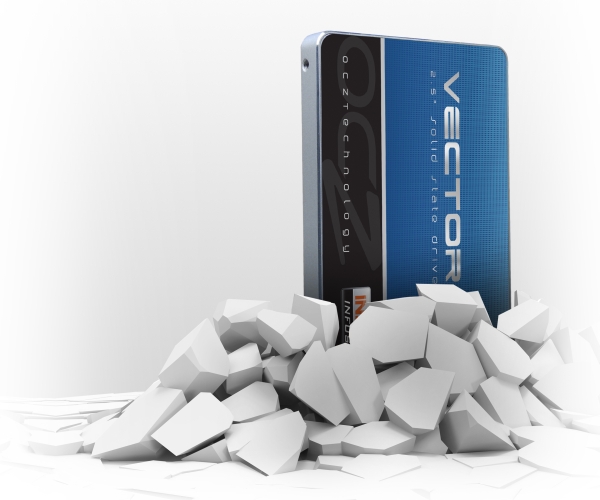Index


Review: Barefoot 3 controller at its best
We managed to get our hands on OCZ's current SSD flagship, the Vector and pit it against Corsair's top offer in a clash of titans. 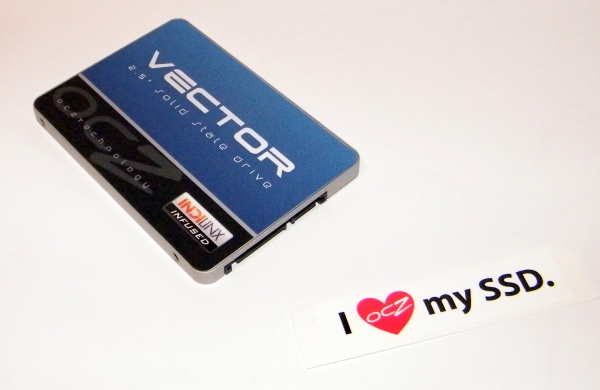
Since it launched late last year, the OCZ Vector has been getting nothing but words of praise, mostly thanks to the company's first in-house controller, the Indilinx Barefoot 3. When it comes to Vector, that same controller was paired up with 25nm IMFT synchronous NAND flash and DDR3L-1600 DRAM chip for cache.
The controller itself is actually a combination of an unnamed ARM Cortex core paired up with OCZ Aragon co-processor. The flash controller with randomizer, ECC Engine and NAND ONFI/Toggle interface is connected to the NAND array via 8-channel and uses DDR2/3 DRAM controller. It also comes with a SATA 6Gbps controller.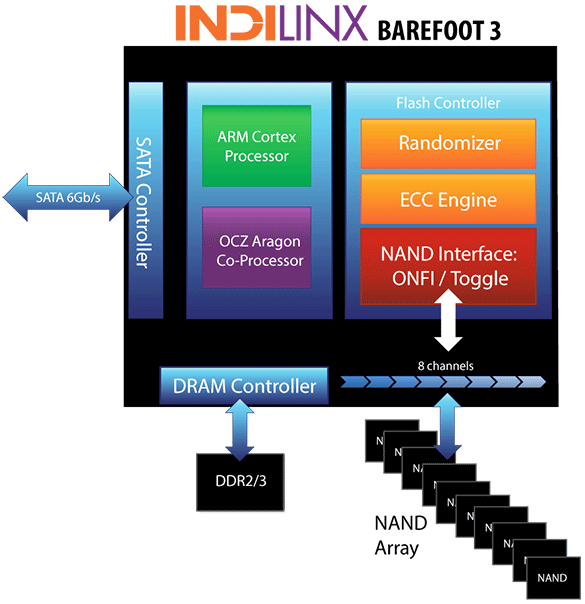
The PCB does not show much unless you want to see OCZ branded 25nm IMFT synchronous MLC NAND flash chips, mentione Indilinx branded Barefoot 3 controller and DDR3L-1600 DRAM cache chip. 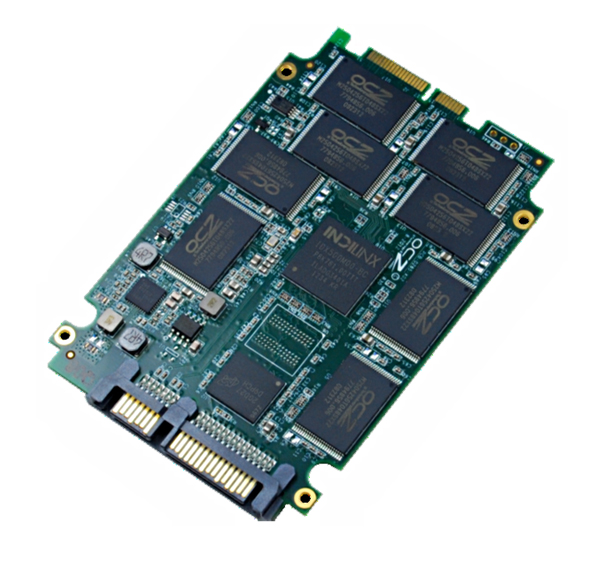
Although OCZ already used Indilinx controller before on its quite famous Vertex 4 SSD, the Vector is the first drive that uses in-house designed controller. The new Barefoot 3 controller is actually the result of a combined effort between engineers that OCZ got from the PLX acquisition, those that came with Indilinx acquisition and guys that already were with OCZ from before.
OCZ also made some quite impressive promises dealing with high reliability, high endurance, high performance and most importantly sustained performance, but we’ll get to those a bit later. According to OCZ, the quality, reliability and stability were the number one priority, thus the 5-year warranty does not come as a surprise.
The Vector’s PCB is placed in a 7mm-thick 2.5-inch form-factor case and although it does not really have any influence on performance it looks differently than what we got used to expect from an SSD. The exact dimensions are set at 99.7x69.75x7mm and it weighs 115g.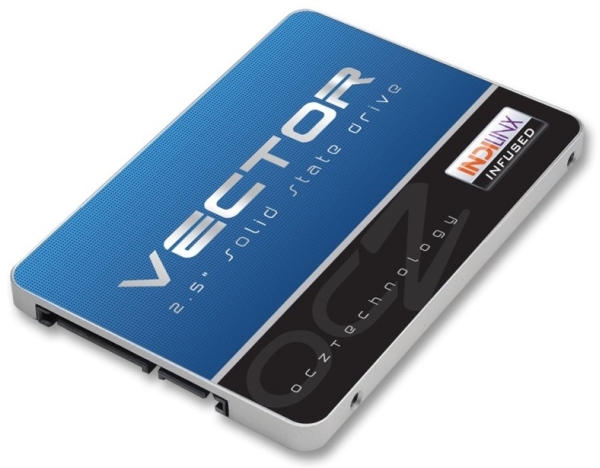
The Vector SSD is available in 128, 256 and 512GB and as it was the case with previous SSDs, those with lower capacities also suffer from lower performance. The feature list includes TRIM, Idle Time Garbage Collection, SMART support, as well as a 256-bit AES-compliant and ATA Security Mode for data encryption.
The 256GB unit is luckily the same as the 512GB model when it comes to performance. Both deliver sequential read and write speeds of up to 550MB/s and 530MB/s, while random 4k read and write are set at an impressive 100k IOPS and 95k IOPS.
The OCZ Vector comes packed in a rather simple but quite informative box that, in addition to the actual Vector SSD also includes a 3.5-inch SSD adapter for desktops, “I love my SSD” sticker and Acronis True Image HD cloning software activation key.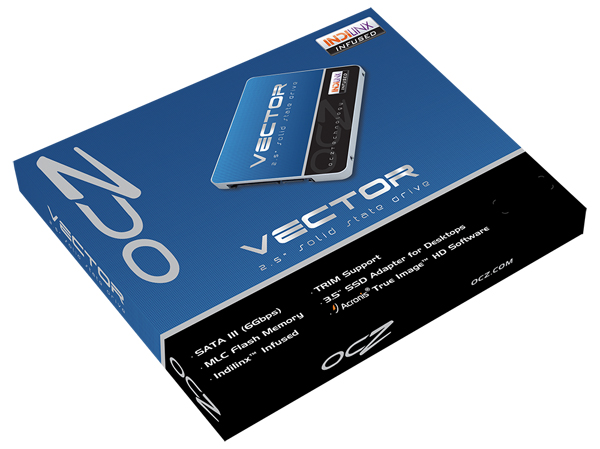
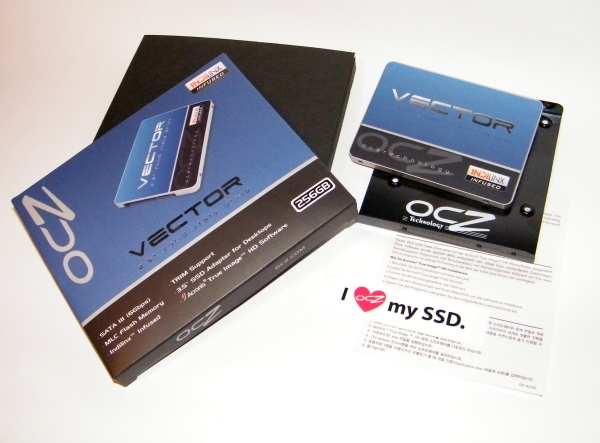
Earlier this year we had a chance to check out Corsair’s Neutron GTX flagship SSD and since we are currently working on a more comprehensive SSD review, the Corsair was reviewed the EVGA X79 FTW motherboard, a temporary solution since we are switching to a Z77-based system and a review that will include few other high-end SSDs as well as some more tests.
The Vector 256GB SSD was for that actually reviewed on Shuttle’s XPC system, kindly provided by Shuttle Europe, that is based on the Z77-chipset which proved as a decent one and gave comparable results.
Of course, all results will be updated and included with the upcoming full review with all the other SSDs and for now we just wanted to see how it performs against Corsair’s Neutron GTX 240GB SSD.
Compressible data is data that shrinks in size when lossless compression is applied, opposite to incompressible data which does not does not shrink or grow in size when compression is applied.
As you can see below, ATTO Disk benchmark certainly favors the OCZ Vector, especially when it comes to reading and writing smaller files which is something that OCZ has been quite proud of. The maximum performance tops out at an impressive 559MB/s for read and up to 554MB/s for write which are definitely the most impressive results we have seen so far in this product class.
Corsair’s Neutron GTX certainly holds its ground, but still loses to the Vector in both maximum speed as well as performance with smaller files.
The AS SSD sequential benchmark, which uses incompressible data for all of its transfers, illustrates performance nicely. Controllers that use on-the-fly compression for example will show big drop in sequential write speed when handling incompressible data.
In AS SSD benchmark the situation is pretty much the same and although Corsair’s Neutron GTX squeezes some impressive performance OCZ Vector simply has superior maximum performance both in read and write scenarios.

CrystalDiskMark 3.0.2 confirms what we had a chance to see previously in the AS SSD benchmark, as we only had some trouble with the 4K QD32 write performance but with such impressive results across the board it is obvious that OCZ/Indilinx Barefoot 3 controller does an incredible job.
OCZ Vector 256GB CrystalDiskMark results
Corsair Neutron GTX 240GB CrystalDiskMark results
Real world performance is usually much more important than the actual synthetic benchmarks and in our upcoming SSD feature we intend to pay a lot more attention to it, with some copy-to-and-from benchmark situations.
For now we’ll have to settle with what PCMark7 and Anvil's Data Storage Utility benchmarks.
PCMark 7 scores for the Vector ar pretty much on par with Corsair Neutron GTX as despite scoring a bit higher we see pretty much close results across the board.
Anvil Storage Utilities simulates a real usage scenario and although Corsair slightly squeezes ahead, according to our test, mostly due to higher 4K QD16 result, OCZ gets back in the game with its superior write performance easing ahead in the total score.

OCZ can be really proud of the Vector. It is a real success, at least from what we had a chance to see in our tests. OCZ certainly had a lot on its hands as Vertex 4 was a good SSD to start with and trying to top that while making promises of high reliability, high endurance, high performance and sustainable performance certainly were not easy.
OCZ needed a good competitor to go against Samsung 840 Pro as you can see from various testing around the net and what we are quite sure that we will see that once we make our big SSD roundup review, it certainly did a good job.
With its first in-house Barefoot 3 controller it can only get better and we surely can’t wait to see what the future will bring. All those acquisitions certainly paid off and there has been a lot of talk regarding the upcoming Barefoot 3 pairing with 20nm MLC which can only bring more competitive and most importantly, more wallet friendly solid-state drives.
Price-wise the Vector gained some value momentum as OCZ now offers Far Cry 3 with every Vector SSD model. In the States, the Vector currently sells for US $149.99, $269.99 and $549.99 for the 128, 256 and 512GB versions. Its direct competitor, the Samsung 840 Pro, sells for around US $149.99, US $239.99 and US $519.99 for the 128, 256 and 512GB models, depending on the retailer/e-tailer and discounts. The Corsair Neutron GTX on the other hand is a bit cheaper and still offers impressive value at US $129.99, $199.99 and US $409.99 for 120, 240 and 480GB models.
In Europe the situation is pretty much similar, as an OCZ Vector can be found with an average lowest price set at €120, €210 and €445 for the 128, 256 and 512GB models, while Samsung 840 Pro breaths down its neck with pretty similar prices depending on the region or the retailer/e-tailer. The Corsair Neutron GTX also offers some impressive value in Europe as well priced at around €110, €190 and €420 for 120, 240 and 480GB models.
As many before us pointed out, OCZ’s main problem is the price and although fixed a bit with Far Cry 3 bundle it is still a bit on the high side. The high-end solid-state drives are still too expensive for an average consumer but the prices are getting more and more reasonable.
We are certainly looking forward to what OCZ has in store with the future of its Barefoot 3 controller and 20nm MLC NAND chips will certainly bring an interesting twist to the market.